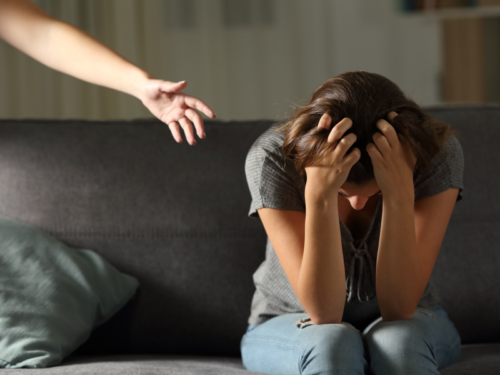
Table of Contents
Tips for Breaking the Cycle of Obsessive Thoughts and Compulsions

Written By: Ethan Cohen BSN, RN

Clinically Reviewed By: Dr. Don Gasparini
July 14, 2025
6 min.
Everyone feels overwhelmed by negative thoughts on occasion, but for people with obsessive-compulsive disorder (OCD), the cycle of obsessive thinking that they experience is severe and can negatively affect their ability to function on a day-to-day basis.
Learn more about our Clinical Review Process
Table of Contents
We all know what it is like not to be able to stop thinking about something. While everyone worries or feels overwhelmed by negative thoughts on occasion, for people with obsessive-compulsive disorder (OCD), the cycle of obsessive thinking that they experience is severe and persistent and can negatively affect their ability to function on a day-to-day basis.
Obsessive thoughts are intrusive, repetitive ideas or images that cause distress and feel impossible to control, such as fears of contamination, losing control, or unwanted taboo thoughts. To relieve the anxiety, many people with OCD engage in compulsions — repetitive behaviors like cleaning, checking, or counting — which provide temporary relief but interfere with daily life. This article will explore why this cycle happens and offer strategies to begin breaking free from it.

We create personalized treatment plans for OCD
Virtual intensive treatment including exposure therapy, medication management, and more.
The OCD cycle happens because obsessive thoughts trigger intense anxiety, which then fuels the need for relief. Obsessions vary from person to person, but they often feel intrusive, uncontrollable, and distressing. How seriously someone believes these thoughts can also affect their impact—some people recognize that the thoughts are irrational, while others may believe them to be completely true. Regardless of insight, the result is the same: a rising sense of fear, discomfort, or unease.
To cope, individuals turn to compulsions—rituals or behaviors meant to quiet the anxiety. These compulsions can be external, like handwashing or checking locks, or internal, like repeating a phrase in one’s head. Sometimes they have a logical connection to the obsession, but often they do not. While engaging in a compulsion does bring temporary relief, the comfort doesn’t last; the obsession soon returns, and with it, the cycle begins again. Over time, this repeated loop can interfere with daily life, keeping the person stuck between fear and ritual.
Five tips on how to break the cycle of obsessive thinking
Living with OCD can feel like being trapped in an endless loop of intrusive thoughts and rituals, but change is possible. While professional treatment is the most effective way to manage OCD, there are also everyday strategies that can help you challenge obsessive thinking and begin loosening the grip it has on your life.
1. Avoid avoiding
Avoiding certain triggering situations and uncomfortable places only gives more power to your OCD thinking. Your obsessive thinking has convinced you that the world is dangerous and that life is something to be feared. More often than not, engaging in your rituals only gives you temporary relief from a fear or anxiety that does not have much grounding in reality.
While it will take patience, practice, and courage, engaging with the world in ways that your obsessive thinking tells you not to can help you realize that life isn’t as scary as you once thought. OCD thinking can make it feel like your fears and anxieties are in control. Challenging your thinking and facing uncomfortable situations can help you practice courage and perseverance in the face of fear and help you take back control of your life.
2. Accept uncertainty
Obsessive thinking is incredibly persuasive. It has a way of convincing you of certain things. The anxious thoughts and fears can drive you to avoid situations that, under different circumstances, you would happily engage in.
When you are trying to engage in an activity that your OCD thoughts are telling you not to, try to ask yourself, “How can I be sure that something bad will happen if I actually do this?” The answer will most likely be that you can’t be sure. In other words, recognizing that your obsessive thoughts might not have the authority you previously gave them can help you let them go to a certain degree.
3. Avoid seeking reassurance
Obsessive thinking can make you doubt yourself. To use the previous example about checking your front door to make sure it is locked, your compulsion to check the door repeatedly comes from anxiety about safety and privacy but also from a lack of self-assurance that you have locked the door the first time. Do your best to recognize that you have locked the door and don’t have to doubt yourself.
4. Practice mindfulness and meditation
Practicing different forms of mindfulness and meditation can aid in slowing down your obsessive thinking and help ground you back to the present moment. This skill set can also be employed when you feel the compulsion to engage in a ritual.
Different forms of meditation and mindfulness practices are effective in alleviating the discomfort that occurs in several different psychiatric diseases and other general medical conditions such as chronic pain.
5. Find a distraction
Obsessive thinking can send your mind into overdrive. Once a fear or anxiety is triggered in your mind, it can feel like that thought has taken over, and nothing else matters except alleviating that feeling with a compulsive action.
Trying to find a distraction that will help redirect your thoughts can be a helpful tool. Disrupting negative thought patterns before they take over through changing your environment, listening to music, watching television, or any other type of distraction can be useful.
How do I know if I have OCD?
As mentioned throughout Charlie Health’s Resource Library, it is important to consult a mental health professional and avoid trying to self-diagnose if you find yourself identifying with any of the information presented above.
That being said, more often than not, the difference between what can be considered normal mental processes and what can be considered diagnosable in mental health is the level at which the thinking patterns and behaviors affect your ability to function on a day-to-day basis.
Here is some information that can be helpful when considering whether or not your mental fixations and associated behaviors might represent a diagnosable mental health disorder.
In general, individuals with OCD:
- Can’t control their obsessive thoughts or compulsive behaviors, even when they recognize those thoughts or behaviors as excessive
- Spend at least one hour per day on these obsessive thoughts or compulsive behaviors
- Don’t get pleasure when performing compulsive behaviors or rituals, but may feel brief relief from the anxiety brought on by obsessive thoughts
- Experience significant problems in daily life due to these thoughts or behaviors

Therapy for breaking the cycle of obsessive thoughts and compulsions
Reaching out to a mental health professional like those at Charlie Health can be a great first step in addressing your obsessive thought patterns. You can learn skills to help better manage your life with obsessive thinking, and through collaboration with your mental health counselor and with a willingness to change, a better life is possible.
Exposure and response prevention (ERP) is one of the most effective treatment modalities for OCD. This therapy, which is a type of cognitive behavioral therapy (CBT), aims to help you confront your fears through planned exposure techniques. It also teaches you skills to delay compulsive behavior. While this type of therapy may sound overwhelming, it is the first-line therapy for OCD and has been shown to be helpful in approximately 80% of cases.
It should also be mentioned that there are several medications that have been shown to be helpful in the management of OCD symptoms that are worth discussing with your mental healthcare provider.

Break free from obsessive thinking—your journey starts here
If you or a loved one are struggling with upsetting, repetitive thoughts or compulsions, Charlie Health is here to help. Charlie Health’s virtual Intensive Outpatient Program (IOP) provides more than once-weekly mental health treatment for dealing with serious mental health conditions, including obsessive-compulsive disorder (OCD). Our expert clinicians incorporate evidence-based therapies into individual counseling, family therapy, and group sessions. With these effective strategies, managing your well-being is possible. Fill out the form below or give us a call to start healing today.




